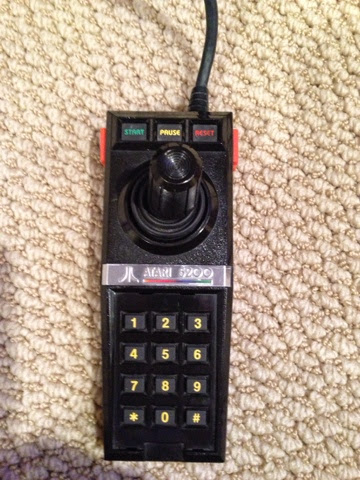I ended up picking up this 5200 for a heck of a price on eBay. It was one of those instances where the seller “couldn’t test the system, but it worked the last time he played it”. So with the great price I was taking the chance it might not work, but the 5200 is a resilient system. When the box with the 5200 arrived I wasn’t very sure what it was. Frankly, the box looked too small and felt too light for the 5200, controllers, the few games, and power box I had bid on. The 5200 was in there though, as was everything else listed in the auction.
Seeing as to how the seller was “unsure” of the system I decided to test it out on my small TV first, so I wouldn’t have to fight my way in and out of the back end of the entertainment center if it didn’t work. I hooked the 5200’s unique power box/RF box up to the small TV and put the first 5200 cart I could grab, Space Invaders, in. The “Fuji” symbol popped up in all its rainbow color changing glory with Space Invaders in bold letters beneath it.
Here’s where a problem occurred though, both controllers wouldn’t work. The one had a hole in the rubber joystick boot and wouldn’t work at all, and neither would the second that looked good superficially. It looked as if I wasn’t getting a chance to play my 5200 right off. So I had a choice, buy a refurbished 5200 controller from TNT Games for $25, which was a better price then I could get on eBay, or try to repair these two controllers. Or there was one other option.
Off to YouTube I went! Where there were more than a few instructional’s on repairing a 5200 controller. Here is a great one http://youtu.be/UADuUdgrbug that outlines how the 5200 controller can be fixed with nothing more than a Phillips and flathead screw driver, and a pencil eraser. Choosing the controller that looked superficially better first, I had the repair done in about 5 minutes. I plugged it in and the start and reset buttons worked great, but the joystick was sticking to the right in game play. Turns out (just as the video tells you) that the white dials play a huge role on joystick calibration. I had to reopen the controller make sure they where in the right spot, and putting the controller back together I had the make sure the joystick stayed center so it would remain calibrated. A good detail to keep in mind, since its very important. The other controller however couldn’t be saved with these repairs, but at least one works.
Now, I’m going to take some time to talk about the RF/Power Box. Many don’t like this setup, and the AVGN even made a huge deal out of it in his 5200 review (watch that here http://youtu.be/AknyR-kRvLc).
Ok, so here’s how this works, the power and video from the 5200 come in through an RCA type jack (top right of photo), basically a long cable comes out of the 5200 for this. The power box (transformer) sits on the floor with one end entering the center of this box and the other being a regular electric cord that can plug into any socket and doesn’t take up a bunch of space. I don’t need to explain the co-axials to you I imagine. The only issue is that the all-in-one power video cable will spark on this box as you hook it up, the AVGN caught this in his video and that does indeed happen upon hookup.
Say what you want but Atari was trying to do some forward thinking here. One (long) cable out of the console, and the wall plug friendly power box where designed to make life a little easier for consumers. Even as a modern gamer with video out, and power out of a console I have to admit an all in one cable out would be nice.
My 5200 is now comfortably set up in the “Atari” cabinet of my entertainment center. It takes up a whole shelf on its own, with my 2600 and 7800 directly below it.
All I can say is even though I only have one working controller, it’s nice to have this system again. The 5200 hasn’t disappointed me and has been just as fun to play as I remembered it. My collection is up to 25 games many if which are titles I remember having as a kid, but my collection also goes a little beyond that now.




Leave a Reply